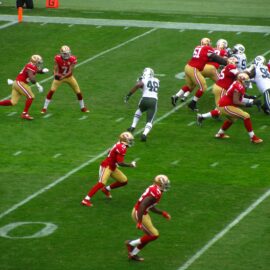

This article is an excerpt from the Shortform book guide to "Sam Walton: Made in America" by Sam Walton. Shortform has the world's best summaries and analyses of books you should be reading.
Like this article? Sign up for a free trial here .
What can you learn by reading Sam Walton: Made in America? How did Walton manage to grow a five-and-dime store into a nationwide superstore?
Sam Walton: Made in America is Sam Walton’s autobiography. Walton details his whole life story, from growing up in a dysfunctional household to purchasing his first retail store to managing over 15k Wal-Marts nationwide.
Here is a brief overview of Sam Walton: Made in America.
Made in America: Wal-Mart’s Story
Sam Walton: Made in America was published in 1992, the same year that Sam Walton died at the age of 74. In this autobiography, Walton covers his life and the history of Wal-Mart, as well as the key strategies and management principles that led them to overwhelming success.
Brief History of Sam Walton and Wal-Mart
Sam Walton began his retail career in 1945 by buying a variety store in Arkansas. The variety store (also known as a “five and dime” store) was a type of retail store that offered a wide range of inexpensive household goods. This was his training ground in retail, where he learned how to compete with nearby stores. Importantly, he learned these sales principles:
- The advantage of lower pricing to generate sales volume
- Having a unique variety of high-quality merchandise
- Running wacky promotions to get foot traffic
After 5 years, his lease expired, and he was forced to sell the store to the landlord. He chose to start over in Bentonville, another Arkansas town. Over a decade, he built up to 15 variety stores across three states.
At this point, Walton was already successful, but he sensed two threats (and potential opportunities):
- The rise of massive superstores, with over 100,000 square feet of floor space, thus dwarfing typical stores and small variety stores like his.
- The rise of discount stores, which were disrupting traditional department stores.
Rather than be disrupted by both of these seismic trends, Walton chose to take advantage of them. Where he had previously built five-and-dime variety stores, Walton would now embark on the path that Wal-Mart is now known for today—large discount stores.
The first Wal-Mart discount store opened in 1962. By 1968, they had 13 Wal-Marts and added on more warehouses.
Critical to Wal-Mart’s success, Walton believed the large retail companies (such as Woolworth) underestimated the opportunity available in small towns. Competitors specialized in metropolitan areas, servicing large populations. Instead, Walton felt that there were thousands of small towns like Bentonville that were being ignored. If Walton’s stores could offer superior pricing and selection locally, he knew customers would prefer to shop there instead of driving into the city.
In 1970, Wal-Mart went public to pay off its debts. Over the next decade, they doubled every 2 years, from 32 stores and $31 million in sales in 1970, to 276 stores and $1.2 billion in 1980, and even more growth up to 1990. For most of Wal-Mart’s life, it has been a literal straight shot up and to the right, replicating its strategy over and over again in towns around the United States, and then the world.
The Wal-Mart Strategy
Wal-Mart was judicious about where to open up stores, and it avoided direct competition with other major discount stores for years. Its early strategy:
- Set up stores in small towns. The Wal-Mart model worked in towns even with a population under 5,000 people, while Kmart only chased cities above 50k.
- As Wal-Mart expanded, they established stores with a radius of a day’s drive from a distribution center. They then filled in that territory, town by town, state by state until they saturated the area.
- If customer experience was good (including cost, quality, selection), word of mouth would drive more traffic. Towns would hunger for Wal-Mart to enter.
People tend to simplify the Wal-Mart success story as “they did discount stores in small towns where big players didn’t want to win.” This ignores the heavy competition they faced from local variety stores, the substitute options its customers had (to drive an hour away to a store in the city), and the execution required to expand as successfully as they did.
Wal-Mart’s Retail Strategies
The mission of Wal-Mart is to reduce the price of living for its customers. Customer satisfaction is their guiding principle—in merchandising, low prices, shopping experience, and more.
- Sam had little sympathy for retailers who closed down after Wal-Mart entered. Customers closed the shop, not Wal-Mart, by voting with their dollars. The existing shops couldn’t compete by offering superior selection, pricing, or convenience relative to Wal-Mart. They shouldn’t exist if they don’t provide the best quality of life for their customers.
Low Prices, High Volume
Sam Walton believed that lower prices brought in more customers, period. Even though a lower markup meant lowered profits, they could more than make up for it with higher volume. In pursuit of lower prices, Wal-Mart omitted frills and passed savings from vendors and efficient operations onto customers.
Experimenting/Innovation
Sam Walton was relentless in his drive to improve Wal-Mart. Never satisfied with where the company was, he boldly experimented with new ideas to improve stores, even creating entirely new retail store concepts.
Innovation was purposefully encouraged by store managers, who had freedom to try crazy things since they had a personal stake in the store’s success. For instance, one store manager once ran a massive promotion, selling 2,500 detergent boxes stacked up in front of the store in an impressive visual display.
Team Participation
Walton considered the Wal-Mart team the most important ingredient in the company’s success. Walton instilled a culture of teamwork in a wide range of dimensions:
- Wal-Mart calls all their employees “associates” to give a sense of partnership.
- Walton believed good ideas could come from anyone, and he eagerly sought opinions from employees on all levels for new ideas.
- Walton believed in liberally sharing private information and company financials with his associates.
- Wal-Mart regularly practiced profit sharing of some kind with employees. Having employees share financially in the success of Wal-Mart made them committed to the company’s success.
Sam Walton’s Management Practices
Sam Walton practiced these essential management practices:
- Learn from the competition—visit their stores and pick up one good idea when you leave. Borrow ideas liberally and improve on them. Competition makes every competitor better, and the customer is the final beneficiary of that improvement.
- Have fun—don’t take things so seriously; don’t walk around scowling all day. Have a “whistle while you work” philosophy. Celebrate successes, and be a bit goofy.
- Innovation—change is a constant, and adaptation must happen. Wal-Mart adopted computer systems earlier than most. It encouraged store managers with autonomy to run crazy promotions.
- Frugality—Walton believed that every time they wasted a dollar, that was a dollar right out of their customers’ pockets.
- Saturday morning management meetings—these weekly meetings were a chance to share best practices, drill down on individual stores and products, and teach new management strategy.
- Servant leadership—management’s role is to serve the individual stores and help them do their job. Managers aren’t above the people on the frontlines.

———End of Preview———
Like what you just read? Read the rest of the world's best book summary and analysis of Sam Walton's "Sam Walton: Made in America" at Shortform .
Here's what you'll find in our full Sam Walton: Made in America summary :
- The story of Sam Walton and how he started Wal-Mart
- How Wal-Mart grew from a single five and dime store to one of the world's largest companies
- Sam Walton's retail strategies and management advice






